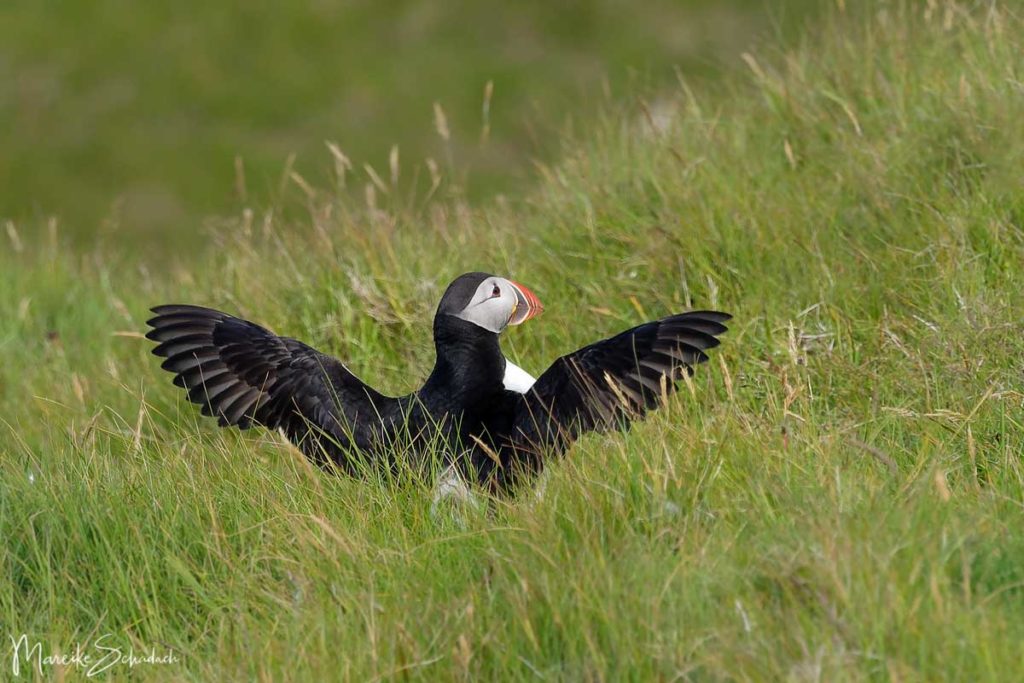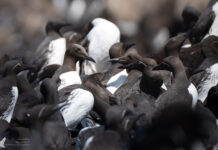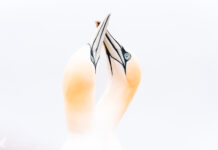Iceland. You want to see puffins? Then Iceland is the right place for you. About 60% of the North Atlantic puffins nest here. The largest colony lives on the Westman Islands. With about 1.1 million breeding pairs, it is even the largest colony in the world.Here you can learn more about the cute puffins. You will also get helpful tips on how to observe the puffins on the Westman Islands.
Unassigned, unpaid advertising. The article contains affiliate links.

Puffin Calendar - What happens when in the Year?
Mid to late April: Puffins come back to Land
Puffins live about half the year on the open ocean. In the Westman Islands, Puffins come back to shore between mid and late April to nest and raise their young. The males arrive first and occupy their breeding burrow from the previous year. Somewhat later, the females arrive in the made nest. Puffins are monogamous, meaning a pair stays together for life. Each breeding pair lays only one egg, which is then incubated by both parent birds for 35 to 38 days.

From the End of June: Feeding Time
As soon as the chick has hatched, both parents fish for what the sea has to offer. The offspring are fed for about six to seven weeks. This is a great time to take photos. If you're lucky, you'll catch a puffin with a beak full of sand eels. The puffins sometimes really fill their beaks when they do this. When they catch a sand eel, they press their tongue against the top of the beak so that they can continue fishing until the entire length of the beak is filled with fish.
Do you need binoculars? I recently bought the Zeiss Terra ED 8×42*. It has good optical performance, is very handy, not too heavy and the price is ok too. It is also waterproof. This is great for paddling or when it rains a little longer.
From mid-August: the Puffins fledge
In August the time has finally come: the little Puffins leave their caves. Normally the moonlight leads them out to sea. But the lights of the city irritate the little ones. Some of them become crash pilots and end up on the streets, where they are exposed to many dangers. But luckily there is the Puffin Patrol! But more on that later.
However, in recent years, it also happened that the parent birds had to feed their young longer. Because of food shortages, the chicks just weren't ready to fly out yet. For example, in 2015, the Westman Islands puffins were on land until October. This affects their chances of survival, as weather conditions then become more adverse.

Early September: Return to the Sea
The parent birds continue to visit the colony for up to three weeks after the young bird has fledged. From September on, the puffins are then exclusively on the open sea. The wintering grounds cover the entire northern Atlantic to North Africa as well as the western Mediterranean.

The best Time of the Day to watch Puffins
Puffins are usually out at sea fishing during the day. Then, they come only briefly to their breeding burrows to feed the young. Usually they disappear so quickly into the breeding burrows that it is difficult to photograph them. In the evening hours it gets a bit quieter in the colonies. Then many animals are on land and can be photographed well in front of their breeding burrows.
Also, puffins seem to like wind and rainy weather. In sunny weather, on the other hand, they are more likely to be hidden in their breeding burrows or out at sea.

Where can you see Puffins on the Westman Island of Heimaey?
Puffins nest on the tops or slopes of grassy, steep cliffs. The breeding burrows are dug into the earth with the beak. To do this, the cliffs must have a sufficiently thick layer suitable for digging. The burrows are about 0.75 to 1.5 meters long and have an opening about 30 - 40 cm wide. At the end of a narrow passage, a breeding chamber about 30-40 cm in size then opens, which is padded with a thin layer of feathers and plant parts.

On Heimay, the main island of the Westman Islands, you will find some good spots to observe puffins:
- Cape Storhöfđi: There are breeding burrows all along the cape. Also, there is an observation hut where you can stay protected from wind and rain and watch the birds in front of their breeding burrows or during their approach and departure. The puffins fly so close to the hut that you can hear the flapping of their wings.
- Mountain Heimaklettur: There is also an observation hut at Heimaklettur. If you don't have much time and don't want to make the long walk to Cape Storhöfđi, then the nearby mountain Heimaklettur is a good place for puffin watching.
- Along the west coast hiking trail:If you hike from the campsite to Cape Storhöfđi, you can see puffins on the cliffs already on the way.
- During a boat trip: During a boat trip around the island of Heimaey you can observe numerous puffins fishing on the water. However, if the boat gets too close, they dive or fly away. I'm always sorry to disturb and startle them. Still, I have to smile every time. It just looks too funny when the Puffins fly up with their too small wings.

You can find even more puffins in my article “Mit Traktor und Heuwagen zu den Puffins von Ingólfshöfði”.
Puffin Patrol and Rescue Center
From about the middle of August the young puffins leave their nest and fly towards the sea. They orient themselves by the moon. However, some of them are distracted by the city lights and fly towards the city. There, the little puffins are exposed to numerous dangers. At this time of year, it is traditional for the kids of Heimaey to walk the streets in the evening with cardboard boxes and flashlights to collect the lost birds. The "Puffin Patrol" brings the found puffins to the Rescue Center. There, the puffins are examined, weighed and measured. The following morning, the kids then release their birds by the ocean. They then fly or swim out to sea on their own.
When I read about the Puffin Patrol for the first time, I was really moved. I would have loved to see that. But I was a bit too early, the chicks were not yet ready to fledge.
Injured or malnourished young birds are cared for and fed at the Rescue Center until they can survive on their own at sea. If you want to learn more about puffins, I recommend a visit to the Rescue Center. It is located in the Sea Life Sanctuary near the harbor.

Are puffins eaten?
Puffins were an important part of the diet in Iceland in earlier times. For this purpose, eggs were stolen from the nests as well as animals were caught with the net. Today, puffins are still caught and eaten - although their species has been classified as endangered since 2015. The trapping season runs from July 1 to August 15, targeting non-breeding individuals between the ages of four and five. On average, 100,000 puffins are caught each year in the Westman Islands.
A decline in puffin populations on Iceland and other colonies in the North Atlantic has been observed for about 10 years. The breeding success of the Westman Islands colony has also been decreasing. Changes in the food web and food shortages are suspected as possible causes. Puffin catches have been reduced on the Westman Islands as a result. Many Icelanders are also increasingly turning away from puffin meat.

Book Recommendations for Iceland
Do you want to know where the journey is going? Then I can recommend this travel guides* to you.
You can order the travel guides on Amazon by clicking on the pictures. If you buy a product via an affiliate link, I get a small commission and you help me to keep filling Fernweh-Motive with interesting articles. This does not make the product more expensive for you.
Guided Tours in Iceland
You don't feel like wandering around on your own and would rather join a guided tour in Iceland? Nothing could be easier. If you book an excursion via the following affiliate links, you will support Wanderlust Motifs with a small commission. The tour will not be more expensive for you. Merci!
Did you also see puffins on your trip to Iceland? Where was that? Do you have any questions or suggestions about my article? If yes, then write me a comment!
Do you want to know when there are new articles on my blog? Then follow me on Facebook, Pinterest or Instagram. I would also be very happy if you share my article with your friends.
Recommendations for further Reading
Do you love the Scandinavian countries as much as I do? Then you might also be interested in my articles about the Kayak Tour in the Swedish Archipelago or a Trekking Tour to the Greenlandic Ice Sheet.











